MITSUBISHI COLT 2008 Owner's Manual (in English)
Manufacturer: MITSUBISHI, Model Year: 2008, Model line: COLT, Model: MITSUBISHI COLT 2008Pages: 450, PDF Size: 14.57 MB
Page 351 of 450
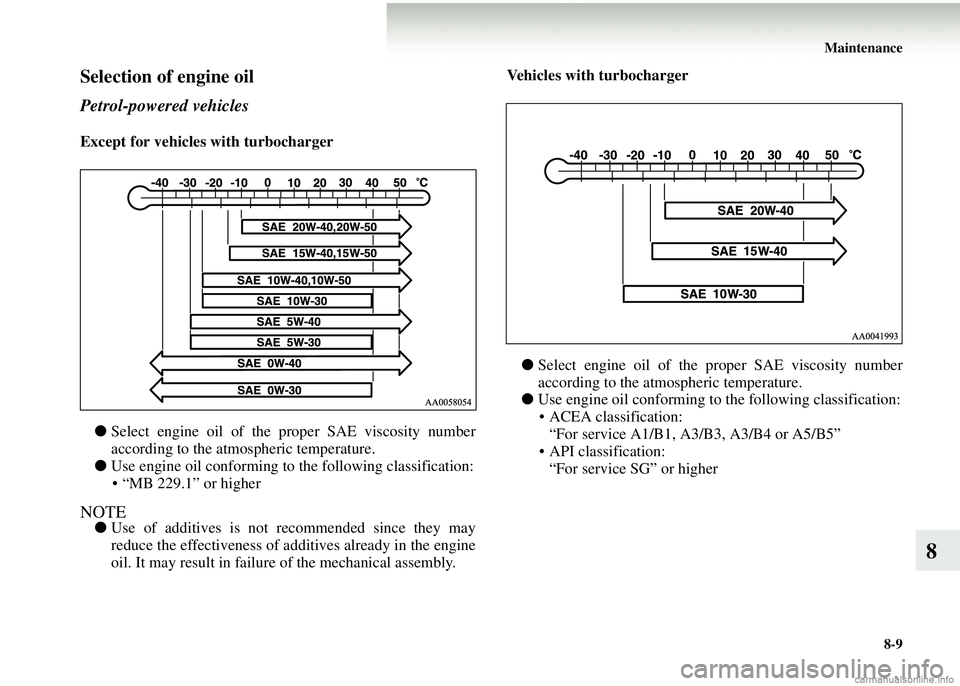
Maintenance8-9
8
Selection of engine oil
Petrol-powered vehicles
Except for vehicles with turbocharger
● Select engine oil of the proper SAE viscosity number
according to the atmosp heric temperature.
● Use engine oil conforming to the following classification:
• “MB 229.1” or higher
NOTE● Use of additives is not recommended since they may
reduce the effectiveness of ad ditives already in the engine
oil. It may result in failure of the mechanical assembly. Vehicles with turbocharger
● Select engine oil of the proper SAE viscosity number
according to the atmo spheric temperature.
● Use engine oil conforming to the following classification:
• ACEA classification: “For service A1/B1, A3/B3, A3/B4 or A5/B5”
• API classification: “For service SG” or higher
Page 352 of 450
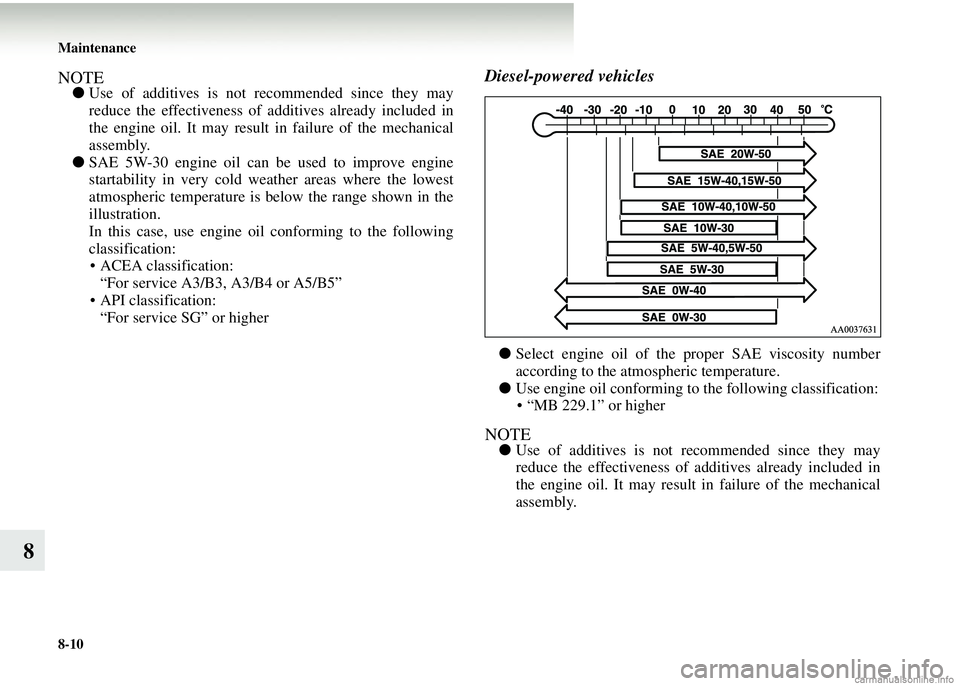
8-10 Maintenance
8
NOTE●Use of additives is not recommended since they may
reduce the effectiveness of additives already included in
the engine oil. It may result in failure of the mechanical
assembly.
● SAE 5W-30 engine oil can be used to improve engine
startability in very cold weather areas where the lowest
atmospheric temperature is below the range shown in the
illustration.
In this case, use engine o il conforming to the following
classification: • ACEA classification: “For service A3/B3, A3/B4 or A5/B5”
• API classification: “For service SG” or higher
Diesel-powered vehicles
● Select engine oil of the proper SAE viscosity number
according to the atmo spheric temperature.
● Use engine oil conforming to the following classification:
• “MB 229.1” or higher
NOTE● Use of additives is not r ecommended since they may
reduce the effectiveness of additives already included in
the engine oil. It may result in failure of the mechanical
assembly.
Page 353 of 450
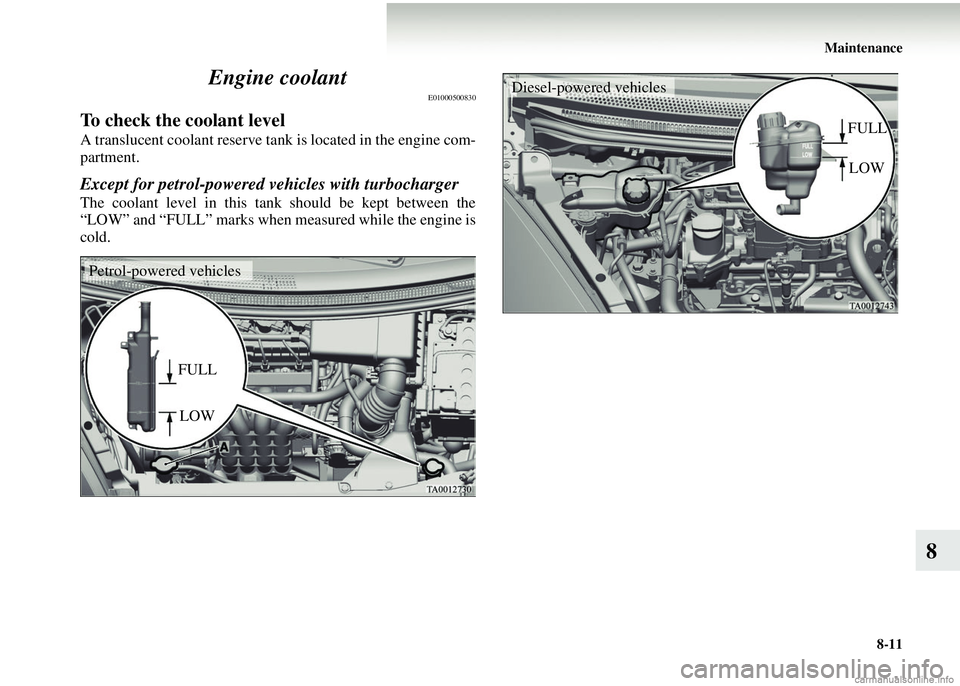
Maintenance8-11
8
Engine coolant
E01000500830
To check the coolant level
A translucent coolant reserve tank
is located in the engine com-
partment.
Except for petrol-powered vehicles with turbocharger
The coolant level in this tank should be kept between the
“LOW” and “FULL” marks when measured while the engine is
cold.
FULL
LOW
Petrol-powered vehicles
Diesel-powered vehicles
FULLLOW
Page 354 of 450
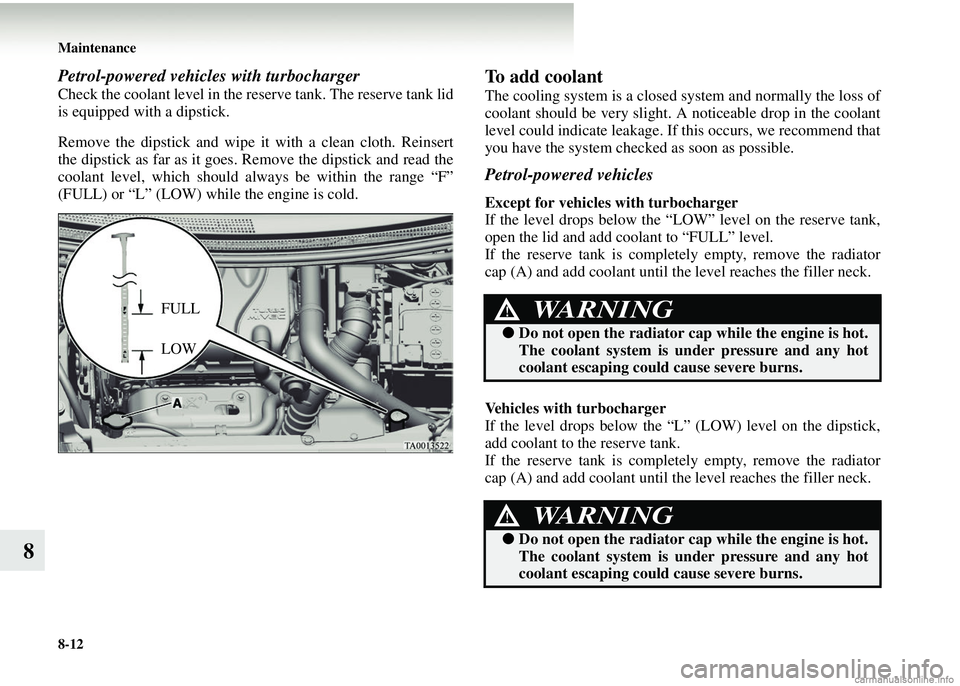
8-12 Maintenance
8
Petrol-powered vehicles with turbocharger
Check the coolant level in the reserve tank. The reserve tank lid
is equipped with a dipstick.
Remove the dipstick and wipe it with a clean cloth. Reinsert
the dipstick as far as it goes. Remove the dipstick and read the
coolant level, which should always be within the range “F”
(FULL) or “L” (LOW) while the engine is cold.
To add coolant
The cooling system is a closed system and normally the loss of
coolant should be very slight. A noticeable drop in the coolant
level could indicate leakage. If this occurs, we recommend that
you have the system checked as soon as possible.
Petrol-powered vehicles
Except for vehicles with turbocharger
If the level drops below the “LOW” level on the reserve tank,
open the lid and add coolant to “FULL” level.
If the reserve tank is completely empty, remove the radiator
cap (A) and add coolant until the level reaches the filler neck.
Vehicles with turbocharger
If the level drops below the “L” (LOW) level on the dipstick,
add coolant to the reserve tank.
If the reserve tank is completely empty, remove the radiator
cap (A) and add coolant until the level reaches the filler neck.
FULL
LOWWARNING!
● Do not open the radiator ca p while the engine is hot.
The coolant system is u nder pressure and any hot
coolant escaping coul d cause severe burns.
WARNING!
●Do not open the radiator ca p while the engine is hot.
The coolant system is u nder pressure and any hot
coolant escaping coul d cause severe burns.
Page 355 of 450
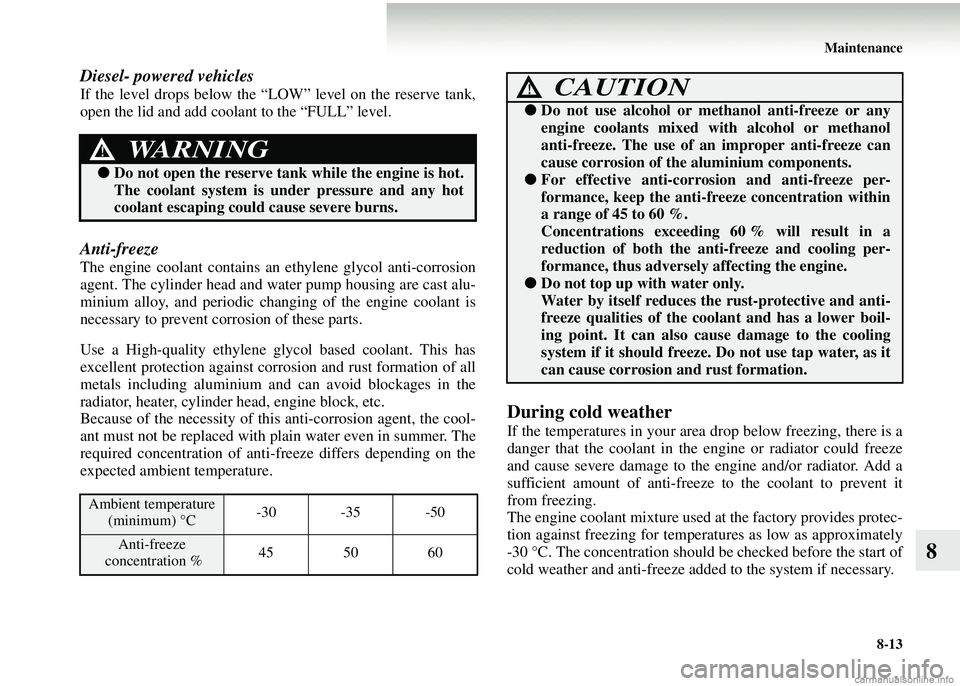
Maintenance8-13
8
Diesel- powered vehicles
If the level drops below the “LOW” level on the reserve tank,
open the lid and add coolant to the “FULL” level.
Anti-freeze
The engine coolant contains an ethylene glycol anti-corrosion
agent. The cylinder head and wa ter pump housing are cast alu-
minium alloy, and periodic changing of the engine coolant is
necessary to prevent corrosion of these parts.
Use a High-quality ethylene glycol based coolant. This has
excellent protection against corros ion and rust formation of all
metals including aluminium and can avoid blockages in the
radiator, heater, cylinder head, engine block, etc.
Because of the necessity of this anti-corrosion agent, the cool-
ant must not be replaced with plain water even in summer. The
required concentration of anti -freeze differs depending on the
expected ambient temperature.
During cold weather
If the temperatures in your ar ea drop below freezing, there is a
danger that the coolant in the engine or radiator could freeze
and cause severe damage to the engine and/or radiator. Add a
sufficient amount of anti-freeze to the coolant to prevent it
from freezing.
The engine coolant mixture used at the factory provides protec-
tion against freezing for temperat ures as low as approximately
-30 °C. The concentration should be checked before the start of
cold weather and anti-freeze added to the system if necessary.
WARNING!
●Do not open the reserve tank while the engine is hot.
The coolant system is under pressure and any hot
coolant escaping coul d cause severe burns.
Ambient temperature
(minimum) °C -30 -35 -50
Anti-freeze
concentration % 45 50 60
CAUTION!
●
Do not use alcohol or me thanol anti-freeze or any
engine coolants mixed with alcohol or methanol
anti-freeze. The use of an improper anti-freeze can
cause corrosion of the aluminium components.
● For effective anti-corro sion and anti-freeze per-
formance, keep the anti -freeze concentration within
a range of 45 to 60 %.
Concentrations exceeding 60 % will result in a
reduction of both the an ti-freeze and cooling per-
formance, thus adversel y affecting the engine.
●Do not top up with water only.
Water by itself reduces th e rust-protective and anti-
freeze qualities of the cool ant and has a lower boil-
ing point. It can also cause damage to the cooling
system if it should freeze. Do not use tap water, as it
can cause corrosion and rust formation.
Page 356 of 450
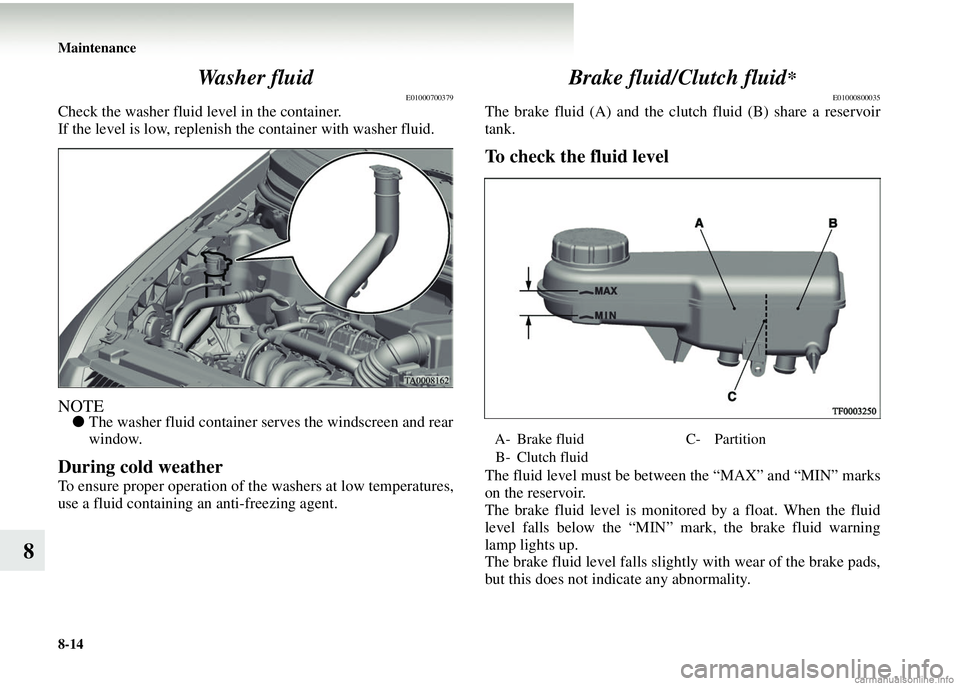
8-14 Maintenance
8Wa s h e r f l u i d
E01000700379
Check the washer fluid level in the container.
If the level is low, replenish the container with washer fluid.
NOTE●
The washer fluid container serves the windscreen and rear
window.
During cold weather
To ensure proper oper ation of the washers at low temperatures,
use a fluid containing an anti-freezing agent.
Brake fluid/Clutch fluid*
E01000800035
The brake fluid (A) and the clutch fluid (B) share a reservoir
tank.
To check the fluid level
The fluid level must be between the “MAX” and “MIN” marks
on the reservoir.
The brake fluid level is monitored by a float. When the fluid
level falls below the “MIN” mark, the brake fluid warning
lamp lights up.
The brake fluid level falls slightly with wear of the brake pads,
but this does not indicate any abnormality.
A- Brake fluid C- Partition
B- Clutch fluid
Page 357 of 450
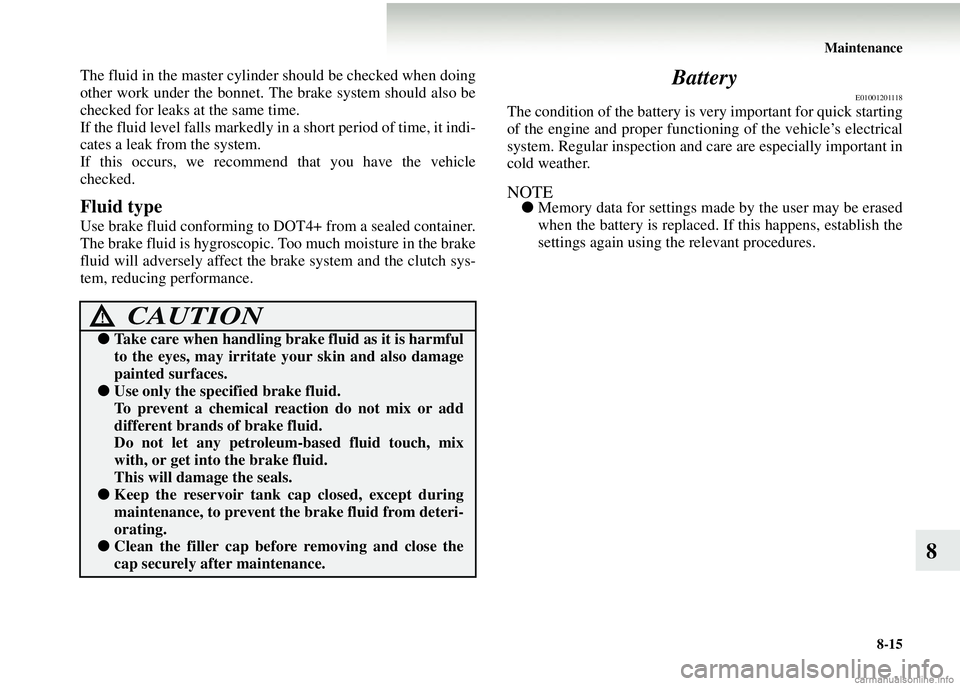
Maintenance8-15
8
The fluid in the master cylinder should be checked when doing
other work under the bonnet. Th e brake system should also be
checked for leaks at the same time.
If the fluid level falls markedly in a short period of time, it indi-
cates a leak from the system.
If this occurs, we recommen d that you have the vehicle
checked.
Fluid type
Use brake fluid conforming to DOT4+ from a sealed container.
The brake fluid is hygroscopic. Too much moisture in the brake
fluid will adversely affect the br ake system and the clutch sys-
tem, reducing performance.
Battery
E01001201118
The condition of the battery is very important for quick starting
of the engine and proper functioning of the vehicle’s electrical
system. Regular inspection and care are especially important in
cold weather.
NOTE● Memory data for settings made by the user may be erased
when the battery is replaced. If this happens, establish the
settings again using the relevant procedures.
CAUTION!
● Take care when handling brake fluid as it is harmful
to the eyes, may irritate your skin and also damage
painted surfaces.
●Use only the speci fied brake fluid.
To prevent a chemical reaction do not mix or add
different brands of brake fluid.
Do not let any petroleum-based fluid touch, mix
with, or get into the brake fluid.
This will damage the seals.
● Keep the reservoir tank cap closed, except during
maintenance, to prevent th e brake fluid from deteri-
orating.
● Clean the filler cap before removing and close the
cap securely after maintenance.
Page 358 of 450
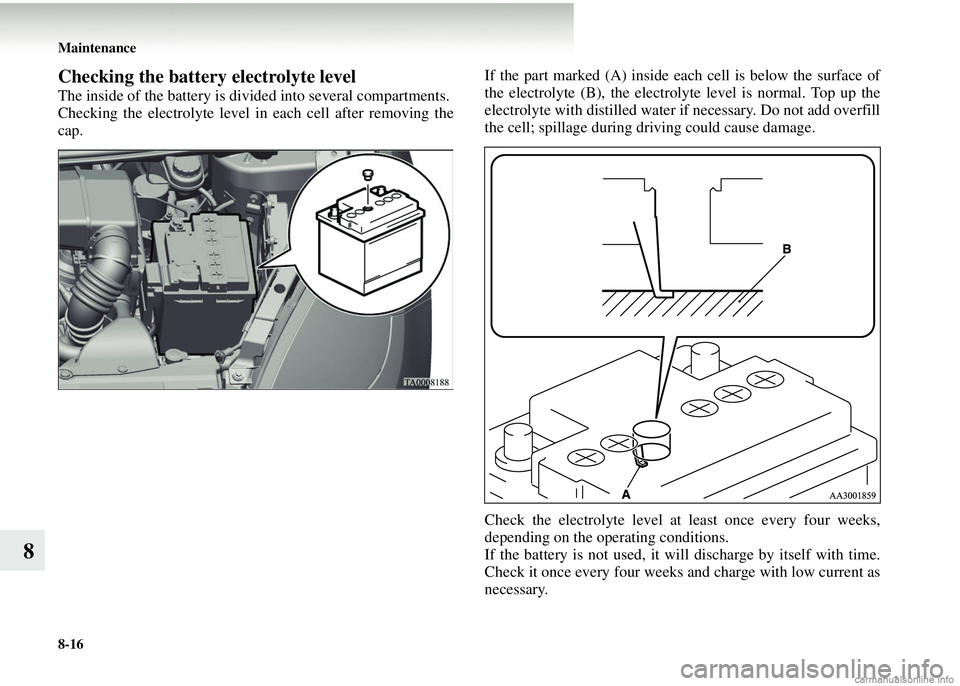
8-16 Maintenance
8
Checking the battery electrolyte level
The inside of the battery is divided into several compartments.
Checking the electrolyte level in each cell after removing the
cap. If the part marked (A) inside each cell is below the surface of
the electrolyte (B), the electrolyte level is normal. Top up the
electrolyte with distilled water if necessary. Do not add overfill
the cell; spillage during driving could cause damage.
Check the electrolyte level at least once every four weeks,
depending on the operating conditions.
If the battery is not used, it will discharge by itself with time.
Check it once every four weeks and charge with low current as
necessary.
Page 359 of 450
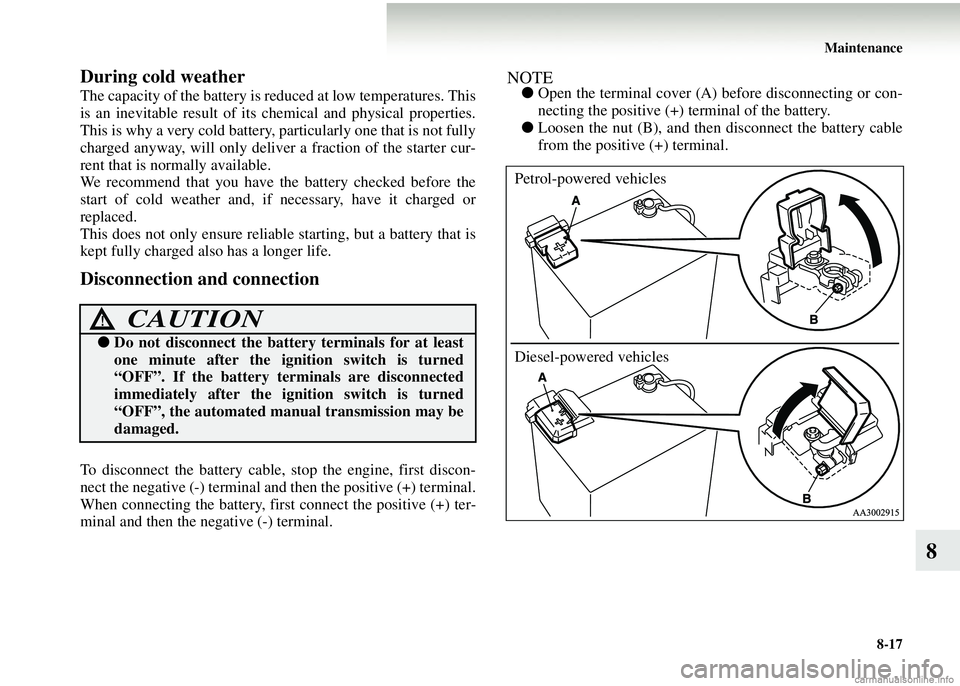
Maintenance8-17
8
During cold weather
The capacity of the battery is re duced at low temperatures. This
is an inevitable result of its ch emical and physical properties.
This is why a very cold battery, particularly one that is not fully
charged anyway, will only delive r a fraction of the starter cur-
rent that is normally available.
We recommend that you have th e battery checked before the
start of cold weather and, if necessary, have it charged or
replaced.
This does not only ensure reliable starting, but a battery that is
kept fully charged also has a longer life.
Disconnection and connection
To disconnect the battery cable, stop the engine, first discon-
nect the negative (-) terminal and then the positive (+) terminal.
When connecting the battery, first connect the positive (+) ter-
minal and then the negative (-) terminal.
NOTE● Open the terminal cover (A) before disconnecting or con-
necting the positive (+) terminal of the battery.
● Loosen the nut (B), and then disconnect the battery cable
from the positive (+) terminal.
CAUTION!
● Do not disconnect the batt ery terminals for at least
one minute after the igni tion switch is turned
“OFF”. If the battery terminals are disconnected
immediately after the igni tion switch is turned
“OFF”, the automated manu al transmission may be
damaged.
Petrol-powered vehicles
Diesel-powered vehicles
Page 360 of 450
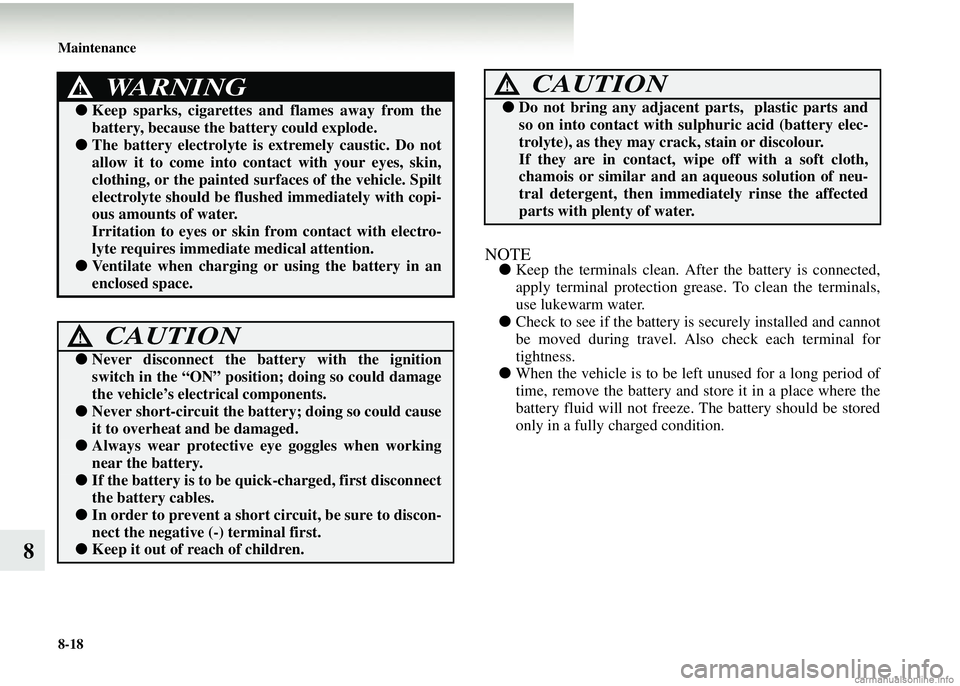
8-18 Maintenance
8
NOTE●Keep the terminals clean. Afte r the battery is connected,
apply terminal protection grease. To clean the terminals,
use lukewarm water.
● Check to see if the battery is securely installed and cannot
be moved during travel. Also check each terminal for
tightness.
● When the vehicle is to be left unused for a long period of
time, remove the battery and store it in a place where the
battery fluid will not freeze. Th e battery should be stored
only in a fully charged condition.
WARNING!
● Keep sparks, cigarettes and flames away from the
battery, because the ba ttery could explode.
●The battery electrolyte is extremely caustic. Do not
allow it to come into cont act with your eyes, skin,
clothing, or the painted surf aces of the vehicle. Spilt
electrolyte should be flus hed immediately with copi-
ous amounts of water.
Irritation to eyes or skin from contact with electro-
lyte requires immediate medical attention.
● Ventilate when charging or using the battery in an
enclosed space.
CAUTION!
● Never disconnect the ba ttery with the ignition
switch in the “ON” position; doing so could damage
the vehicle’s electrical components.
● Never short-circuit the battery; doing so could cause
it to overheat and be damaged.
●Always wear protective eye goggles when working
near the battery.
●If the battery is to be qui ck-charged, first disconnect
the battery cables.
● In order to prevent a short ci rcuit, be sure to discon-
nect the negative (-) terminal first.
●Keep it out of re ach of children.
●Do not bring any adjacent pa rts, plastic parts and
so on into contact with su lphuric acid (battery elec-
trolyte), as they may cra ck, stain or discolour.
If they are in contact, wipe off with a soft cloth,
chamois or similar and an aqueous solution of neu-
tral detergent, then imme diately rinse the affected
parts with plenty of water.
CAUTION!